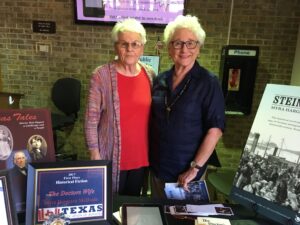
The Oblate Fathers arrived in Texas in 1849 to serve as missionaries, and soon became known to Mexican ranchers in the Rio Grande Valley as the “Cavalry of Christ.” The padres, young men from the big cities in France, wore an Oblate cross over their plain black, ankle-length, long-sleeved soutanes (cassocks). In addition to mastering Spanish and English, they faced the added challenge of learning to ride horses and burros on 100 to 150-mile circuits. They traveled over dusty, mesquite-choked trails to reach ranches scattered along the Mexican

border.
The Mexican-American War ended the year before the Oblates reached the Valley, throwing the new arrivals into a tumultuous period of cattle rustling and general lawlessness. Both the United States and Mexico became embroiled in civil wars and the region was plagued by natural disasters like yellow fever and periodic hurricanes.
Residents along both sides of the river loved their French padres, especially Father Pierre Yves Keralum, known to the Mexican people as Santo Padre Pedito for his humility, his obedience, and his kindness. He’s also remembered for the mystery surrounding his death.
Father Keralum, an architect and master builder, combined preaching, baptizing, and marrying people with designing and constructing Gothic Revival style churches all along the Rio Grande. In 1854, he was assigned to Roma, a new mission center covering a large area upriver about halfway between Brownsville and Laredo. As part of his ministry, Father Keralum designed and constructed of Our Lady of Refuge Church.
When an Oblate superior who had started the design of the massive church at Brownsville, drowned at sea, the Oblates called on Father Keralum to take charge of the building project. He modified the plans and in 1859 completed Brownsville’s massive Immaculate Conception Church (designated a Cathedral in 1874) with its beautiful vaulted ceiling. (In 1960, fire and smoke damaged the hand-polished mesquite alter and pulpit and some of the chandeliers.) In addition to the church he also designed the convent, priests’ house, and the college building.
Along the Rio Grande, many tiny chapels survive on former ranches and at mission stations where the Oblates stayed during their long circuit rides. One of the mission centers, La Lomita, which served about sixty-five area ranches, sits on land the Oblates inherited from René Guyard, a fellow Frenchman. The reconstructed chapel is south of Mission, a citrus-growing center that was named for La Lomita and spreads over much of the Oblates’ original ranch.

The Villa de San Agustín de Laredo (city of Laredo) was established in 1755 around the present plaza. A small stone church served until 1872 when Father Keralum designed and the diocesan priests built the present Cathedral of San Agustín with its 141-foot bell and clock tower.
After twenty years of traveling at least three times annually on horseback, visiting seventy to 120 widely scattered ranches along the Gulf coast and the interior, Father Keralum––age fifty-five––was frail and nearly blind. On November 9, 1872, despite the misgivings of his fellow Oblates, he mounted his horse and rode away from Brownsville. He stopped about forty miles away at a ranch northwest of present Mercedes before he disappeared. His horse was found contentedly grazing. For a time people suspected murder. Over ten years later, some cowhands found his remains, which were identified by his Oblate belongings. Perhaps he followed a cattle trail by mistake, became entangled in a thicket, and dismounted to rest. Speculation suggests a rattlesnake bit him or he simply became lost and died of weariness and starvation.
His legacy, and that of his fellow missionaries, survived in the lives of those they touched and in the handsome churches that dot the landscape of the Lower Rio Grande Valley.

Fascinating. Such hard times and strong people.
Yes, Bruce, they were a different breed.
Excellent, excellent Myra. You are talented and I dearly love your stories.
Beverly
On Fri, Oct 21, 2016 at 4:48 PM, Myra H. Mcilvain wrote:
> myrahmcilvain posted: ” The Oblate Fathers arrived in Texas in 1849 to > serve as missionaries, and soon became known to Mexican ranchers in the Rio > Grande Valley as the “Cavalry of Christ.” The padres, young men from the > big cities in France, wore an Oblate cross over their p” >
Thank you, thank you, Beverly. You are a faithful reader.